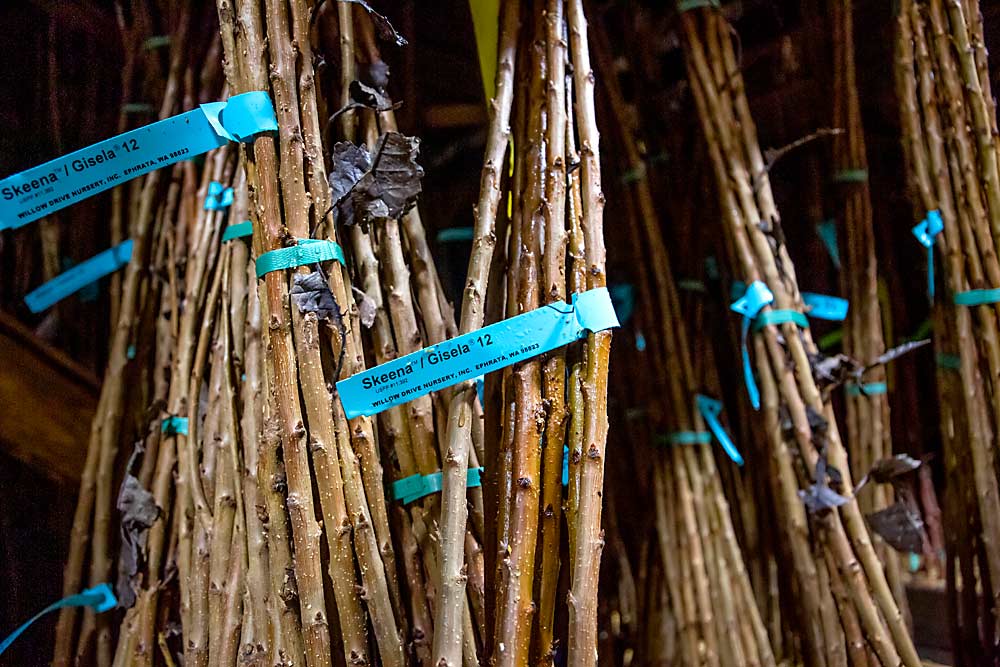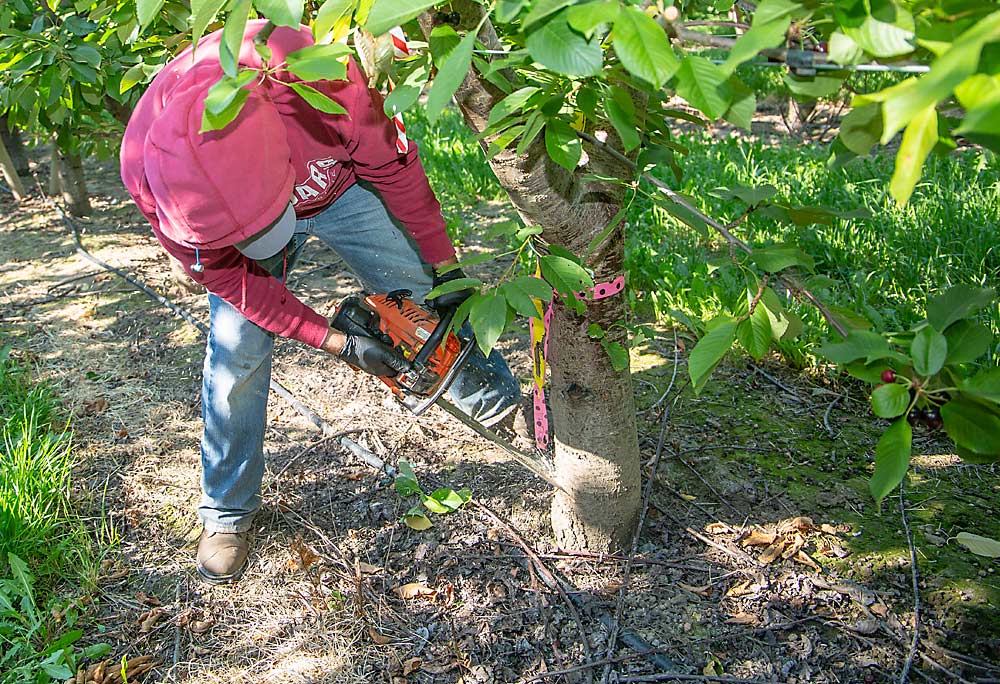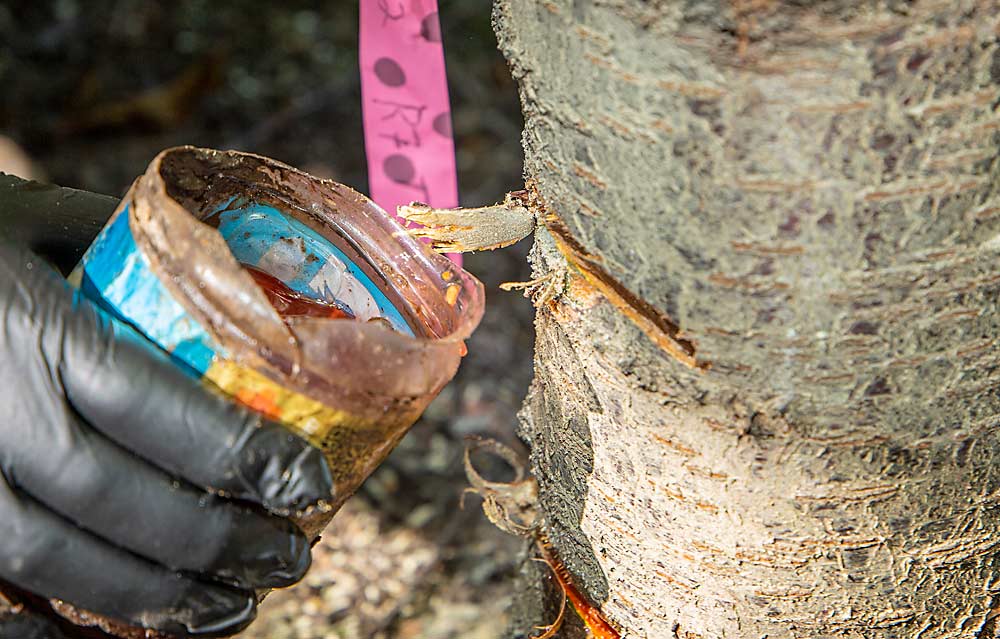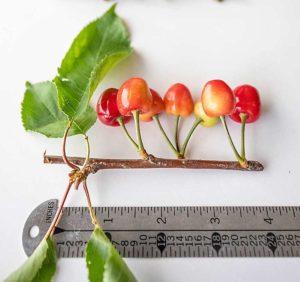
Washington growers have pulled more than 685 acres of cherry orchards in the past few years due to infection with X phytoplasma or little cherry virus. Both pathogens result in unmarketable fruit — a condition the industry collectively calls little cherry disease — but it is the former that has created an industry-threatening epidemic.
Tree removal, currently growers’ only remedy for both pathogens, cost the industry $18.2 million in lost production in 2020, said Washington State University virologist Scott Harper. When considering the cost to replace those orchards and the lost revenue while new blocks grow into production, he estimated an $81 million toll on the industry — and counting.
Those removals (and undoubtedly more to come before the industry reins in the epidemic) will require a lot of replanting in the years ahead. That’s put a spotlight on the certified clean nursery tree supply and best practices to protect planting stock and newly planted orchards.
“The easiest way to get a pathogen is in infected trees,” said Harper, also director of the Clean Plant Center Northwest. But through the Washington tree fruit certification program, he said, practices are in place to “safeguard the supply chain — from us at the Clean Plant Center through the nurseries to the growers.”
Over the past year, nurseries have been working closely with the Little Cherry Disease Task Force — a group of research and extension staff, growers and the Washington State Department of Agriculture — to ensure nurseries have the best practices in place to reduce the risk of spreading disease. So far, they say it’s working.
“We don’t have any indication that certified trees pose a risk to orchardists in spreading little cherry disease,” said Cindy Cooper, who leads the WSDA’s plant protection division that oversees the tree fruit certification program. “This is just a wake-up call about the importance of clean planting material.”
The goal of the certification is to give nurseries and their customers confidence, said Gary Snyder, co-owner of C&O Nursery, who also chairs the WSDA’s fruit tree certification advisory committee. And nurseries are prepared to make additional changes, if needed, to protect a clean tree supply as they learn more about X disease management.
“We are doing the best we can with the tools we have to work with. The question is: Is there a better way?” Snyder said. “At the end of the day, there’s good standard operating procedures in place, and if there are things that can be done to do it better, why wouldn’t you?”

Certification protection
All 16 of the state’s certified nurseries plant their registered mother blocks with material from the Clean Plant Center. The mother trees at nurseries are regularly tested and monitored for symptoms for a wide variety of pathogens, said Lauri Guerra, director of the WSDA certification program.
“We don’t certify the individual trees; we certify the process,” he said. The process by which the nurseries propagate has many protective procedures in place, he said, and it’s designed to adapt to the pathogen challenges facing the industry — such as the new requirement to monitor for the leafhoppers that are vectors of X disease.
In the 17 years he’s been watching for X disease in the state’s certified mother blocks, Guerra said he only found one positive in a tree used for seeds, not budwood cuttings. Phytoplasmas are not seedborne.
“I am pretty confident,” he said of the process. “There is no evidence that this is a nursery-borne problem.”
But there’s no resting on laurels in the face of an epidemic.

With the current levels of X disease prevalence across Washington, it’s only a matter of time before an infected leafhopper transmits the pathogen to a certified nursery mother tree, Guerra said. But he’s confident that with the procedures in place, the WSDA and nursery owner will catch it, promptly remove the infected trees and aggressively test other material to detect any additional spread.
“Our role here is to minimize the chance of it moving into the registered blocks,” Guerra said. “If it moves in, we have to be very aggressive and remove it as soon as possible.”
The certification program takes a proactive approach, Guerra said, adapting requirements as new information becomes available.
As scientists learn more about the role that native perennials and broadleaf weeds seem to play as a reservoir for X phytoplasma, the certification program will now ask nurseries to be more aggressive with weed management in both the mother blocks and fields of young trees, Guerra said. Monitoring for leafhoppers and testing them to see if they are carrying the phytoplasma should also help nurseries identify risks sooner.
“By testing the leafhoppers, we will have a real-time picture of the situation — while when we test trees, we have a picture of what happened two to three years earlier, at best,” Guerra said.
Nurseries push clean plant message
The first epidemic of X disease in Washington in the 1940s, so named because no one knew the causal agent or vector, inspired the establishment of the Clean Plant Center in Prosser, said Bill Howell, manager of the Northwest Nursery Improvement Institute. That’s when the industry realized the importance of clean plants and invested in it, funding the certification program with a
1 percent fee on all nursery trees sold in the state.
“Our nurseries want to do the testing to help growers have confidence in the product,” Howell said.
Sources for this story estimate that certified nursery trees account for about half of the fruit trees planted in Washington every year, maybe less. The importance of clean plants can go unappreciated until there’s a problem, Howell said.
“As customers, the orchardists need to ask what the source of the scion wood is when they are placing an order,” said Dale Goldy, a cherry grower and owner of Gold Crown Nursery in Quincy, Washington. Growers aren’t always willing to wait on tree orders if there is not enough certified supply available.
He predicts a rise in tree demand in coming years, as growers plant at higher density and replace infected blocks.
Most certified nurseries sell both certified and noncertified trees, so it’s on growers to pay the extra for certification if they want what Harper said is “that assurance that steps have been taken to ensure it isn’t carrying harmful pathogens.”
But clean plants are just the first step. Harper and WSU extension specialist Tianna DuPont caution growers not to rush to replant if there’s still high disease pressure in the surrounding area.
Minimizing the risk of leafhopper transmission is a concern for nurseries and growers alike, Goldy said.
“From my own experience, you can plant a clean block and in a very short period of time, if you have (X disease) present in your neighbors’ orchards or rangeland around you, it’s going to move on to you,” he said. “What concerns me the most is for me as a nurseryman to sell clean, certified trees and to have a grower come back in a year or two and tell me they have a problem.”
Replanting and recovering from X disease and little cherry disease is going to take transparency on best management practices from all facets of the industry, Snyder said.
“Viruses are never any fun, but sometimes they are good to bring people together,” Snyder said. “We want the confidence of everyone involved from tree fruit research to orchardists to nurseries. We need to protect ourselves in our backyard.” •
—by Kate Prengaman







Leave A Comment